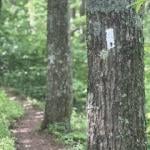Today’s USA TODAY has an interesting article on p. 3 entitled “The USA Is Getting Its Goats.” It’s about people and various entities in the U.S. increasingly using goats and sheep to keep the brush, weeds, and grass clipped. They’re using them to replace lawnmowers. It’s better for the environment and cheaper. No more spraying chemicals. This article compares the costs in detail.
Sheep eat grass, and goats eat everything else but grass. Both of them eat all day, only laying down to take a brief rest occasionally. I like sheep, first, and goats, second. When I was a child, living near Yakima, Washington, I was allergic to cow’s milk. So, my mother bought a goat, milked it, and fed me goat’s milk. One day, that goat butted her so bad in her butt that she got mad and sold him. Many years later, again in Yakima, I almost became a sheepherder in order to keep the grass clipped low.
I’m an idea guy. Always have been. I constantly get ideas. I think of how to improve something that already exists or create something new that makes life just a little bit easier. See my previous posts about “Inventing a Better Golf Club” (“Part 1” on 6/24, “Part 2” on 7/1, and “Part 3” on 7/9.) That’s why I started an invention business five years ago. (See trianglebook.com.) I think some of my ideas are pretty good, but some of them are absolute hairbrainers. That’s what I always thought about my idea for using sheep, that is, until I read this article today. Now I’m thinking maybe that idea wasn’t so bad after all.
I was born in Seattle, Washington, went to college in Houston, Texas, and lived most of my life there. But during the 1970s, I purchased 60 acres of land just outside the city of Yakima. My primary purpose for acquiring this land was to build a nine-hole golf course on it with an experimental course design I had thought of as a teenager due to reading books on the history of golf and old golf course design. My idea was to build the course so that one day golfers would play it in one direction, and the next day they would play the course in the opposite direction. It would have one extra green and two sets of tees for each hole. I called it “the reversible course,” which wasn’t a new name.
In fact, my reversible course idea wasn’t new, either. That’s how golf started. The Old Course at St. Andrews, England, was the first golf course in the world. At first, it consisted of only three golf holes that went straight out. Then the golfers turned around and played those same three holes backwards to their original starting location. Eventually, that added three more holes that continued straight out. My reversible course idea was basically the same, but with added improvements. No golf courses had ever been constructed like I planned to make mine. And no golf courses had been played forwards and backwards since the early history of golf, a game that started in Scotland and then England about 500 years ago.
However, there has always been much dispute about the early history of golf. I think its because those golfing Scots drank too much of their own, refined whiskey and thus couldn’t remember what they did. Some people say that golf has eighteen holes because those Scots would sip a nip from the bottle on every tee, and the bottle was dry after eighteen holes. That’s surely how they got the term “19th hole.”
In 1981, I decided not to compete on the PGA TOUR that summer. Instead, my family and I spent the entire summer in Yakima as an experiment to see if I wanted to make this golf course idea become a reality. I used heavy equipment to clear the land and shape the greens throughout the summer. But soon after we arrived there, I implemented one of my hairbrain ideas. I told my wife Marilyn and our three children–Christy, Monica, and Michael–“Go to the stockyard auction and buy three sheep.” They said, “What for?” I didn’t want to tell them. Because, when I then did so, they all said, “Are you crazy?” I’ve been accused of worse.
Nevertheless, they did what I said, coming back with three rather unruly, and very wooly, white sheep. I built a wire pen for them, which didn’t always work. I spent some wasted time chasing and catching sheep. Why the sheep? I wanted to see how well they would eat grass. That is, I wanted to know if they would keep the turf cut low enough to play golf on it. That’s how golf was played for centuries in the old country. Their lawnmowers were sheep.
Did my three sheep keep the grass cut down enough to play golf on it? The jury was still out on that one. As for the golf course I was starting to build, at the end of that summer I had to abandon the idea. My life, and that of my family, would have been quite different if I had carried through with it.
That summer, I phoned my close friend Joel Goldstrand in Minnesota. We had been roommates in college, he was best man in my wedding, and he played the Tour for a few years. Joel was now the club pro at Minneapolis Golf Club and designing golf courses in his spare time. I asked Joel various questions about grass and course design. When I told him my unique course design idea, he thought it was a terrific idea and asked me if I’d mind if he tried it. I told him OK, but I said I didn’t want him to talk about it much. If I completed my project, and golfers liked it, I might make golf course design my future occupation. I didn’t, but Joel did. During the 1980s he designed and built eight, reversible, nine-hole golf courses in Minnesota and Iowa. They were the first such golf courses ever constructed in the Western Hemisphere. They still exist. I’m told that the golfers who play them love their unique golf course.
Well, my family returned from that stockyard auction with one more animal–a cute puppy dog. He was half Black Labrador and half Weimaraner, and he became our family dog for the next fifteen years. The kids gave him his name and had a big laugh doing so. What was it? They knew that I didn’t like my middle name and that I wouldn’t ever tell it to anyone unless I had to. I was a junior, so I got it from my dad, and he got it from my Zarley grandparents.
What is it? Millard! As in Kermit Millard Zarley Junior. Now, that’s a whackey, hairbrain idea for a name if ever there was one. Comedian Bob Hope thought so, too. I’m glad he didn’t know about the Millard part. No telling what he would have done with that.
(In 1965 on national television, Bob Hope nicknamed Kermit Zarley “the pro from the moon” because of his unusual name.)












